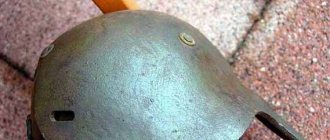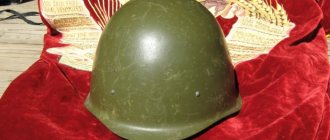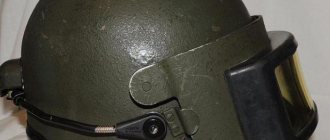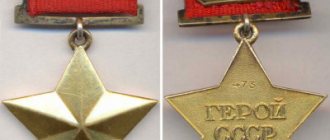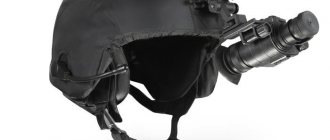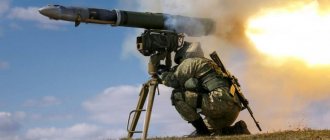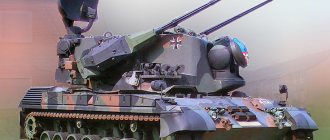SSh-36 (also known as “Khalkhingolka”) is a personal protective equipment for a soldier of the Armed Forces of the USSR, a steel helmet of the 1936 model.
The first Soviet-made steel helmet adopted by the Red Army. In other sources, the name of the helmet is found during the period of its development, “Red Army steel helmet of the 1935 model.”
Personal protective equipment for military personnel of the Red Army and Red Army, was widely used in the Armed Forces by the Soviet Union during the battles of Khasan and Khalkhin Gol, in the Polish campaign of the Red Army, in the Soviet-Finnish War and in the initial period of the Great Patriotic War. Its use by Soviet soldiers of some units during the Soviet-Japanese War in 1945 is also noted. The SSH-36 was worn like all other helmets with a liner.
Knives in Rus'. Story
Date: 12/30/2021
Unlike swords, spears and axes, knives in Russia were extremely common. This, in particular, is evidenced by archaeological material, in which this category of finds amounts to dozens...
More details
The heritage of past times, which has acquired material and cultural significance for our contemporaries, is usually called the term “antiques”. These can be masterpieces of painting or other works of art, handicrafts of artisans, factory-made or factory-made products. Items common in everyday life, items of clothing, weapons of various types, personal accessories and much more - all this is a subject of interest to those who consider it a great success to buy antiques as an investment or as an addition to a personal collection.
Comb for helmet SSH-36 (Khalkhingolka), high-quality copy.
The Khalkhingolka helmet, also known as the steel helmet SSH-36, was adopted by the Red Army in 1936. It had the characteristic wide brim and low visor, which (according to legend) were invented by Budyonny - to protect against saber strikes. There was a small hole on the top of the helmet for ventilation. It was covered with an overlay in the form of a comb. The SSh-36 was the main helmet of the Red Army until 1940, when the SSh-40 appeared, a Soviet helmet from the Great Patriotic War.
For the first time, Soviet soldiers had to fight wearing SSh-36 helmets on Lake Khasan in 1938. Northern China and Korea were occupied by Japan at that time. But in addition, the Japanese liked a certain Zaozernaya hill, 150 kilometers from Vladivostok. Why they needed it is not known. But one fine day, stubborn samurai crossed the border, occupied this hill (as well as the neighboring one), set up machine guns and dug in. Like now it’s ours.
It is clear that if this happened in our time, the Japanese would not have to cross the border. They would have simply sold the hill to them, and for two hills there would have been a discount. By the way, if you buy three, the fourth is free. However, during the time of Comrade Stalin, such “border clarifications” in favor of neighbors were not practiced. A group of mountain tourism lovers, numbering about a division, arrived at the scene of the incident and took the hill by storm. In the photo below, Red Army soldiers in SSh-36 helmets are planting a flag on the top of the Zaozernaya hill:
However, the samurai did not stop. The next year (1939) they already liked something from Mongolian territory. Namely, the region of the border river Khalkhin Gol. In the summer of 1939, the Japanese, with the support of tanks and aircraft, invaded Mongolia in order to slightly clarify the border. 40 kilometers in your favor. Since Mongolia at that time was building communism like Russia (and the Mongols were ready to build anything as long as the Chinese and Japanese would leave them behind), the USSR had to sign up for the fraternal Mongolian people. A full-scale 4-month war began, where more than 100,000 soldiers participated on both sides. The Japanese were defeated. Soviet troops on the Khalkhin Gol River were entirely wearing SSh-36 helmets, which is where the name of this helmet came from - Khalkhin Gol .
Of course, today some historians allow themselves to criticize the role of Comrade Zhukov at Khalkhin Gol. They say that he is not the father of victory. He just commanded the corps (albeit in the decisive sector), and all the troops were led by Army Commander Grigory Stern. In addition, the plan to encircle the Japanese was not invented by Zhukov, but by his chief of staff, a little-known officer Mikhail Bogdanov, a forgotten talent. And Zhukov at Khalkhin Gol, as usual, only acted tyranny - he shot his soldiers and officers right and left for anything they hit, and sent them into unprepared attacks with the goal of overwhelming the Japanese with corpses. In general, victory always has many “fathers”, and defeat is always an orphan. There are many opinions today, but one fact is undeniable: at Khalkhin Gol, the samurai were attacked by guys in Khalkhin gols, and not vice versa.
Khalkhin Gol was a local conflict. Then things got tougher. They had barely finished with the Japanese in September 1939 when the Red Army’s Liberation Campaign against Western Ukraine and Belarus began. It was urgent to free Western Ukrainians and Western Belarusians. From the Polish authorities.
There are many stereotypes about pre-war Poland - nationalist dictatorship, Pilsudczyk, pacification of Ukrainians, “ghetto shop” for Jews. This is all true, but against the background of its neighbors - the Third Reich and the USSR, pre-war Poland was simply a beacon of democracy and human rights. During the so-called During the pacification (calmification) of Ukrainians in Eastern Galicia in 1930, 50 people were killed and 5,000 were arrested. In Russia, during the pacification of Russians in Tabmov in 1921, about 50,000 people were killed. Another couple of million Ukrainian collective farmers were calmed down (in the cemetery) in 1932-33. Everything is learned by comparison, however.
In the external arena, the Poles behaved proudly as usual, relying on their Western allies. But in vain. As a result, they fell under the Molotov-Ribbentrop Pact. From a moral point of view, with this pact the USSR entered into a conspiracy with the aggressor for the purpose of looting (the eastern Polish lands). And not just with the aggressor, but with Hitler. And from a military-strategic point of view, I must admit, the pact was a brilliant step. He saved the USSR in 1941. 300 extra kilometers, colleagues. In the summer of 1941, the Germans had to travel 300 extra km across the Baltic states and former Eastern Poland. Because of the pact. Otherwise, they would have finished with the Balts in a week or two and would have been right outside Narva - 130 km to St. Petersburg. These 300 km came back to haunt the Germans in November 1941. When they crawled to Khimki and the count went into kilometers and meters.
By the end of the war, Khalkingols remained en masse only in the Far East.
They can be seen in a number of photographs of the Soviet-Japanese War of 1945. The war was fleeting, only three weeks. During the first 2 of these, Soviet troops passed through all of Manchuria and captured a number of key points at sea. Then the Japanese began a general surrender and surrender. After the Soviet-Japanese War, the combat history of the SSh-36 ends. Then the Khalkingolka goes into the category of military antiques.
Sale of military antiques
The sale of antiques dating back to the period of World War II traditionally attracts a wide range of buyers. You can buy such goods from private collectors, as well as from those involved in military archaeology. If you are interested in the opportunity to buy military antiques in Moscow, then here, in addition to individual sellers, there are specialized stores that are happy to offer you items related to the front and rear of the Great Patriotic War.
Military antiques: online store Antik1941.ru
Our antique store is located in Moscow.
Antik1941.ru was founded in 2004 and today is a large specialized platform for the sale of antique items from the Second World War, World War I, and the Vietnam War. Many years of experience in the specialized market and extensive connections have allowed our store to form one of the most extensive collections of military antiques, the diversity of which we are in a hurry to present to Antik1941.ru clients. For anyone interested in antiques, the online store Antik1941.ru offers the following types of goods:
· weapons of the Second World War, as well as other military campaigns mentioned above; · military uniform of the Red Army, the Wehrmacht and other warring parties; · items of soldier's and officer's life: equipment, ammunition, dishes, personal belongings and much more; · awards: a large selection of Orders and Medals.
Antik1941.ru including a numismatic online store: we offer ancient and rare coins, banknotes, bonds.
About our products and the work of the store
All items and weapons that our online store offers are genuine, which is guaranteed by many years of experience and our authority among customers. The products contained in the Antik1941.ru catalog correspond to their descriptions, the results of which are available to customers. At the same time, the prices in our store are some of the best on the market. Delivery of purchased military antiques is carried out by courier in Moscow, as well as to the regions of Russia using postal services. You can find out more about any of the products presented, as well as find out more about delivery options by calling the numbers listed on the website.
Our online resource is an excellent find for professional antique dealers, collectors and history buffs. Often those who want to make an original gift come to us. The trade in military antiques has become increasingly popular in recent years, and the desire for great moments and mysteries of history is increasingly disturbing the hearts of our compatriots. Many agree that nothing can bring a person closer to an era better than things from seemingly forgotten times. With the help of antiques, the war and its way of life become accessible not only from the point of view of harsh front-line chronicles, but also through clear examples, which are the exhibits that our antiques store presents.
On non-involvement in Nazi propaganda
It was Antik1941.ru that assembled an amazing collection of military antiques, which is regularly updated with new arrivals. The most extensive collections are paraphernalia and objects of the workers' and peasants' Red Army and the Third Reich. Numerous things that belonged to the German army and its soldiers quite often have fascist symbols applied to them. We hasten to assure that the sale of such items should in no way be associated by our customers with the propaganda of a prohibited ideology. It’s all about the historical authenticity of the collection and the desire to present history from its true position.
Story
In the 1920-1930s, the Red Army used helmets of the “Hadrian’s Helmet” type, which appeared in the Russian Army in 1916, as well as helmets of the M17 type - in relatively small quantities. The M29 helmet, developed in 1929, as well as the M30 helmet from 1930, never went into production.
In mid-1934, the People's Commissariat of Defense of the USSR issued an assignment to develop a steel helmet for the Red Army that would meet the conditions of modern combined arms combat. In the same 1934, a prototype presented to the military leadership was personally tested by Marshal of the Soviet Union S. M. Budyonny, chopping the helmet with a saber. On his initiative, the helmet that was eventually put into service received wide side brims designed to protect the fighter’s shoulders from a slashing blow from top to bottom (the brims were supposed to deflect the blade from the shoulder).
In 1935, the Lysvensky Metallurgical Plant began production of a new type of helmet developed by Schwartz, adopted for service in 1936 and designated SSh-36.
The new helmet has an original hemispherical shape with a protruding visor and side sloping brims. Its silhouette resembled a German steel helmet.
SSh-36 became the first helmet developed and put into mass production in the USSR. The SSH-36 received its baptism of fire during the war in Spain, where it was supplied to the Republicans and international brigades.
In the summer of 1938, steel helmets were used during the fighting at Lake Khasan. Based on the results of an analysis of the injuries received by Red Army soldiers during the fighting near Lake Khasan, it was found that the presence of a helmet made it possible to reduce the mortality rate of Red Army soldiers from skull wounds to 5.8% (while during the First World War, mortality from skull wounds of the Tsarist army who did not have metal helmets was 50%).
Subsequently, it was actively used by the Red Army in the battles at Khalkhin Gol, where it received the nickname “Khalkhingolka,” as well as in the Winter War and the Polish Campaign in 1939. However, during its application, a significant number of shortcomings were identified. Thus, the wide brim created a “sail effect” and made it difficult for the soldier to move, and the large visor reduced visibility. It was for these and other reasons that in 1939 work began on the next helmet, which later received the name SSh-39, then SSh-40. Beginning in 1940, the Red Army began gradually replacing the SSh-36 with helmets of a new model, but the outbreak of the Great Patriotic War pushed back this replacement, which is why the SSh-36 was used mixed with the SSh-40 by Soviet soldiers until about 1943.
At the same time, some Soviet soldiers used this helmet during the Soviet-Japanese War in August - September 1945, which there is a lot of evidence of in newsreels shot by Soviet documentary filmmakers. In particular, this is reflected in the 19th episode of the documentary film “The Unknown War” (USA-USSR, 1978).
In the post-war years, SSh-36 was sometimes found among fire crews.
Sale of antiquities: household items, antique dishes, antique paintings
Why buy antiques?
When we talk about antiques, we mean not only military items and weapons - this is only part of the story, accompanied by various military actions. However, besides war, there is peacetime, which also has many of its own characteristics, traditions and types of leisure.
Collectors, amateurs, art critics and even investors often give preference to the everyday life of ordinary people: household items and crafts, ancient paintings, antique dishes - all this can immerse you in history not through abstract stories, but through concrete images and things, compare the history and development of your countries with others and learn more about them.
Antique value
The interest of collectors and investors is explained by the rarity of the item, which increases its value. Antiques are an asset that constantly increases in value! Everything loses its value over time, but not antiques. However, is it only the price that makes people hoard “junk”?
Among collectors, along with specialists, scientists and investors, there are also simply connoisseurs of high-quality interior items or wardrobe items. The fact is that antique dishes, furniture, and clothing were of incomparably high quality. Any Soviet item of clothing or USSR porcelain (dishes, figurines) can be used to this day. And objects of earlier eras and rural life, which retained their authenticity, were made by hand, and therefore have a special magnetism for connoisseurs and scientists. Antique porcelain, antique jewelry, silver - have a recognizable mark and a guarantee of quality - the mark of the manufacturer / country of manufacture, the hunt for which is especially exciting. Soviet porcelain figurines depicting the national features of the peoples of the USSR, their way of life, type of activity, significant events and personalities are made with particular historical accuracy. They give birth to three-dimensional images in the head, a sense of the importance of each profession, events and the general spirit of the times.
Antique painting
Antique paintings are the object of discussion, debate and study by art critics around the world. This is not at all like modern oil painting, given the changing technologies for manufacturing materials and mass production. Painting is an antique that never ages, never wears out and always has its value. It reflects the historical past, the spiritual development of the era, its philosophy and ideology. Iconography has a special place in painting. There are almost magical meanings here. Just imagine what power an icon must have, having received divine conversions for tens, perhaps hundreds, of years.
Such treasures often become subjects of research not only by scientists and amateurs, but even by esotericists and mystics. So many books are devoted to the phenomenon of ancient artifacts. By the way, pay attention to rare books! Today there is an abundance of fiction and art books, however, many are the result of numerous reprints that replenish the mass market. But we suggest taking a closer look at the primary sources, assessing the scale and quality of ancient publications.
Selling antiques in Moscow
Through antiques we learn the history, traditions, technologies of our ancestors and can not only tell children about their great-grandfathers, but also show living evidence. When you hold ancient objects or a real military relic in your hands, you feel your unique energy, learn some secrets and solve riddles, imagining a person who drinks tea from this mug every day or looks at this picture. What is he thinking about at this moment? In this regard, interest in such things will never dry up, giving rise to corresponding demand.
In our store you will find all antiques. You can even buy candlesticks, jugs, inkwells, hourglasses, icons, mirrors, sculptures, antique porcelain and much more from our catalog as a gift - this is a truly original surprise.
Review of steel helmet SSh-36 / “Khalkhingolka” / “Hasanka”
Review article about the steel helmet SSh-36 Photo: Soldiers wearing the SSh-36 “Khalkhingolka” helmet. Selection-2 Koto: Helmet SSH-36 “Khalkhingolka”. Selection-1
The steel helmet of the 1936 model SSH-36 or the “Khalkhingolka” or “Khasanka” was adopted by the Red Army in 1936. Sometimes the helmet is called “Eared” . According to legend, S.M. himself The SSh-36 its first baptism of fire in Spain, where there was a civil war in 1936-1939. Helmets were supplied to Spain as military aid to the Republicans. Then in 1938 in the Far East on Lake Khasan, when Japanese troops decided to occupy the Zaozernaya hill, 150 km from Vladivostok. Perhaps they didn’t have enough parts of Northern China and Korea, and they decided to hoist the Japanese flag on the territory of the USSR, but that’s a different story. As a result of the battle, the Japanese troops left the hill in defeat. Attached is a photo of the USSR flag on top of the hill. After the defeat at Lake Khasan, Japanese troops decided to “squeeze” part of the territory from Mongolia, which was already part of the USSR. So in the summer of 1939, Japanese troops, supported by tanks and aircraft, entered 40 km into Mongolia. Thus began a four-month full-scale war for Soviet Mongolia. More than 100,000 soldiers took part in the conflict on both sides. The Japanese were defeated. And the name “Khalkhingolka” received precisely during this war, when all Soviet troops were dressed in SSh-36 in the border area of the Khalkhin Gol River. After a baptism of fire in the area of the Khalkhin Gol River, SSh-36 had to experience the Finnish frosts during Winter War and liberate Western Ukraine and Belarus from Polish rule.
"Khalkhingolka" was the main helmet before the start of World War II and was supposed to replace the outdated Adrian M1916 and Sohlberg M17 helmets. SSh-36 became the first domestic helmet, which began to be mass-produced for the needs of the army. The helmet was made of steel 1.1 mm thick and weighed 1200-1300 grams. Weight depended on size; there were 4 helmet sizes and 8 liner sizes (from 53 to 60). The liner was borrowed from the Schwartz M-30 helmet, which was not adopted for service. The balaclava was made of fabric with an adjustable cord. Inside the balaclava there were aluminum strips that performed shock-absorbing functions and provided additional ventilation. Three rivets were used to fasten the helmet to the liner in the area of the aluminum tape. The chinstrap for the helmet was made of leather or fabric, and their length was adjusted using square buckles. There is a small ridge at the top of the helmet, under which there is a ventilation hole. SSh-36 "Khalkhingolka" was painted dark green.
of the SSh-36 “Khalkhingolka” during combat operations , it turned out that the wide fields for protection against sabers that S.M. insisted on. Budyonny created a “sail” effect, and the visor reduced the fighter’s visibility. Also, the protective properties of the helmet from bullets and shrapnel left much to be desired. The SSh-36 "Khalkhingolka" ended its combat career in September 1945 with the surrender of the Japanese army.

